The story of Canada’s CF-105 Avro Arrow jet interceptor remains arguably the most controversial chapter in Canadian aviation history,
Now surprising blueprints of the Canadian supersonic jet interceptor developed by the Canadian A.V Roe company in the late 1950’s, have resurfaced and are on display at a small museum in Saskatchewan.
Ordered destroyed by then Prime Minister John Diefenbaker along with everything else connected with this leading Canadian ‘Arrow’ design, the sheaves of blueprints had secretly been saved and are now on loan for public display at the Diefenbaker Canada Centre in Saskatoon as part of their display on the iconic Avro Arrow.
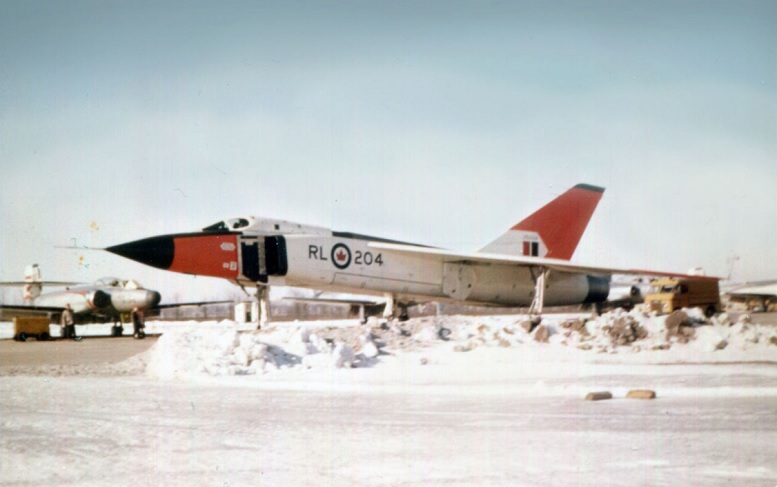
Arrow RL-204 in late 1958 sits ready on the pad at the Downsview, Ontario A.V. Roe plant. Originally all-white, Dayglo orange highlights had been added to enable easier spotting in the white snow in case of a crash (Don Rogers,wikimedia)
The controversy surrounding this amazing plane arises from the fact that it is widely believed the Canadian designed “Arrow” was far and away the most advanced military interceptor of its time. Canadian aeronautical engineers and designers were also at the leading edge of innovation and invention. However, the now well-advanced programme with six completed jets, five of which had flown and were exceeding expectations with even greater potential likely, was suddenly cancelled on “black Friday’ of February 20, 1959. This was apparently due to ever increasing costs and a changing military technology which included development of intercontinental ballistic missiles.
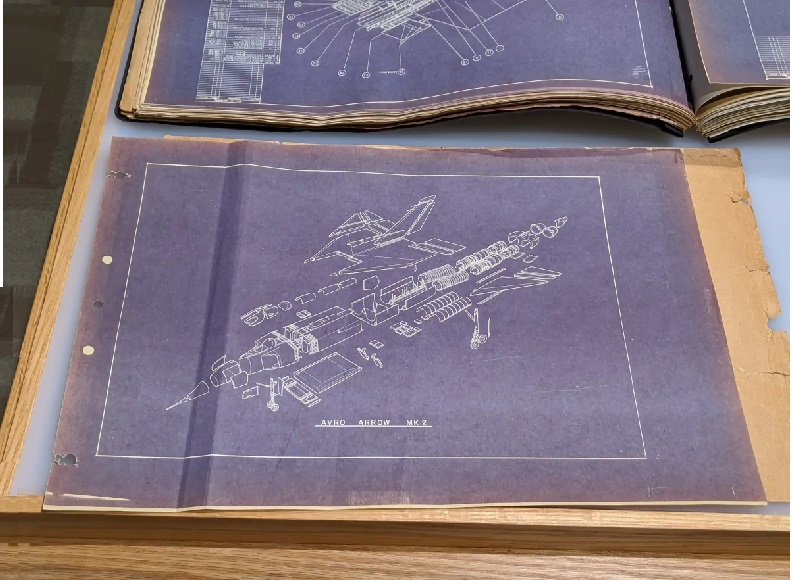
The blueprints of the iconic Arrow had been secretly saved by an A.V Roe draughtsman (submitted by Diefenbaker Canada Centre via CBC)
While that cancellation alone would have struck a blow to Canada’s technological advances and the future of Canada’s aerospace industry, the shocking insult to the thousands of workers at the plant was the additional order to destroy the planes, the specialised jigs and tools, and blueprints.
- RCI: 2014: Black Friday 1959- Arrow: Death of a future legend
- RCI: 2018: An ‘Arrow’ will fly again
- RCI: 2018: Arrow legendary jet replica languishes
- RCI: 2018: Historic Arrow test model recovered
The plane was designed as a high speed interceptor of Soviet bombers over the Canadian north, but the argument was that missiles could do the job against bombers, bombers themselves (and thus manned jet fighters) were becoming obsolete due to ICBM’s, and the Canadian plane was becoming just too expensive.
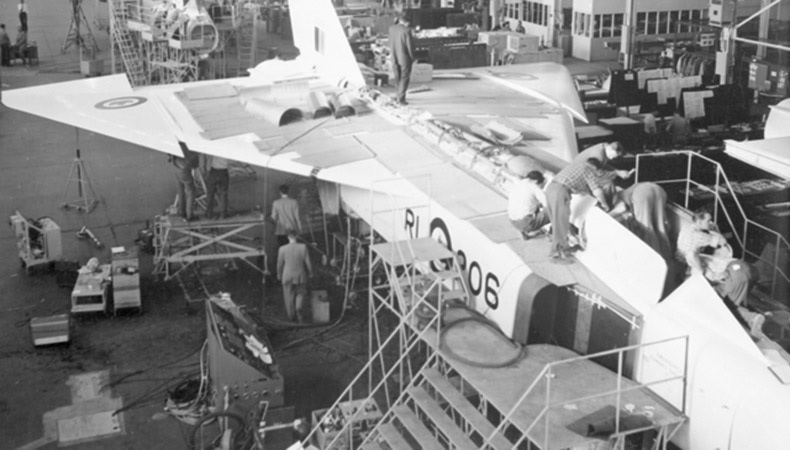
RL-206 was almost entirely complete in the hangar when the destruction order came. Tests with the other five Arrows had shown enormous potential, meeting and exceeding expectations ( Canadian Aviation and Space museum 1967.1262)
Many have argued ever since of the short-sightedness of the arguments, certainly as shown by the ongoing need for manned jet fighters and the lingering question of how Canada’s aerospace sector would have flourished had the programme continued.
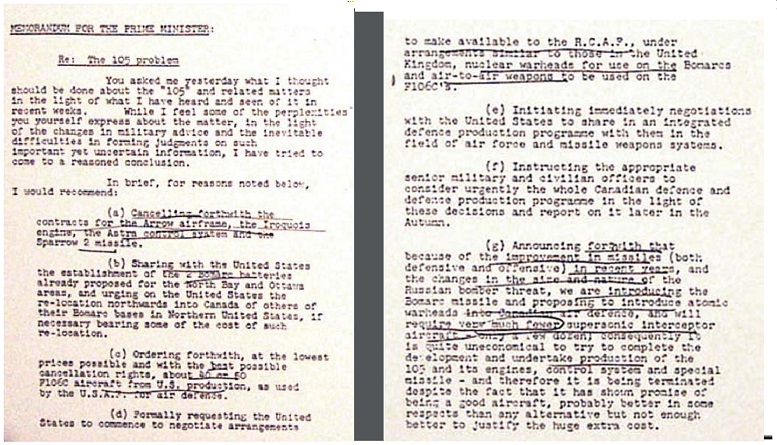
The beginning of the end? Two pages of a five page note from R.B Bryce, Clerk of the Privy Council to Prime Minister Diefenbaker, dated Sept 5, 1958. It recommends immediate cancellation of the Arrow programme, instead ordering 50 or 60 U.S F-106c fighters, arranging with the U.S. for nuclear warheads for Bomarc missiles, and sharing in an integrated air and missile defence production programme. In a page for “reasoning” for cancellation of the Arrow programme point 6 notes ” I have considered Mr. Golden’s (sic) argument that use of U.S aircraft instead of their own would be a slap in the face of the Canadian industry, but I think that can be answered best if the numbers to be bought are so small that the cost of the Canadian planes are obviously out of all proportion to the U.S planes even if the 105 is a somewhat better plane. (SCAA) (full document-here)
Conspiracy theories
That cancellation and destruction order has reverberated throughout Canada ever since. Many felt, (and still feel) the U.S had been pressuring Canadian politicians to buy their fighter jets, although hard proof is lacking. It is interesting to note the Canadian engineers were immediately snapped up by American and other aeronautics firms. Hints of Arrow innovations were seen later on various U.S jets, while one of the engineers helped develop the lunar lander, and another worked on the Concorde supersonic jet. This has led to suspicions of American influence to scuttle the world-leading Arrow in order to prevent competition for sales of their jets, and to acquire the engineers suddenly thrown out of work in Canada.
Another mystery and conspiracy is the apparent disappearance of RL-202. While a period photo shows all the planes lined up outside for destruction, a later photo shows 202 missing. A famous Canadian writer, June Callwood, living near the A.V. Roe plant remembers hearing the distinct sound of an Arrow taking off the day of the cancellation. Another person in England distinctly remembers as a teenager seeing an unmarked plane exactly like the then highly distinctive Arrow landing at RAF base Manston in the early 1960’s.
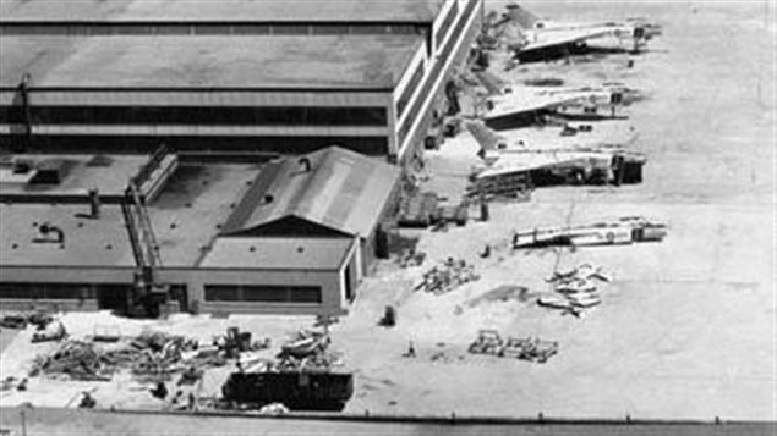
Rumours of the order to destroy the planes was leaked but security was tight, An intrepid reporter hired a small plane to fly over the plant to capture images of the destruction. An earlier photo shows Rl-101 to 105 in line, (106 was inside on the production line almost complete). This photo of the destruction shows 202 missing (via Vintage Wings)
Did someone safely escape with 202? If so, it’s a secret still.
Blueprints.
Of course when the word suddenly arrived at A.V. Roe of the termination notice, and the order to destroy literally everything connected with the plane, there was incredible shock and disbelief.
Rumours that some people snuck bits and pieces out of the building seem to be true as over the years some items have come to the surface. The latest of these are two books of blueprints. These should have been destroyed, but Ken Barnes, a senior draughtsman at the plant in 1959, apparently couldn’t stomach the thought of destruction and secretly smuggled the plans out and kept them in his basement for decades. His son has now decided to loan them to the Diefenbaker Canada Centre for their display of the Arrow story.
As for his father, Ken Barnes went on to work for SPAR aerospace, which was originally a department (Special Projects and Research) of the A.V Roe company, which folded in 1962 after the Arrow cancellation. SPAR later developed the world-famous Canadarm used on the U.S space shuttle.
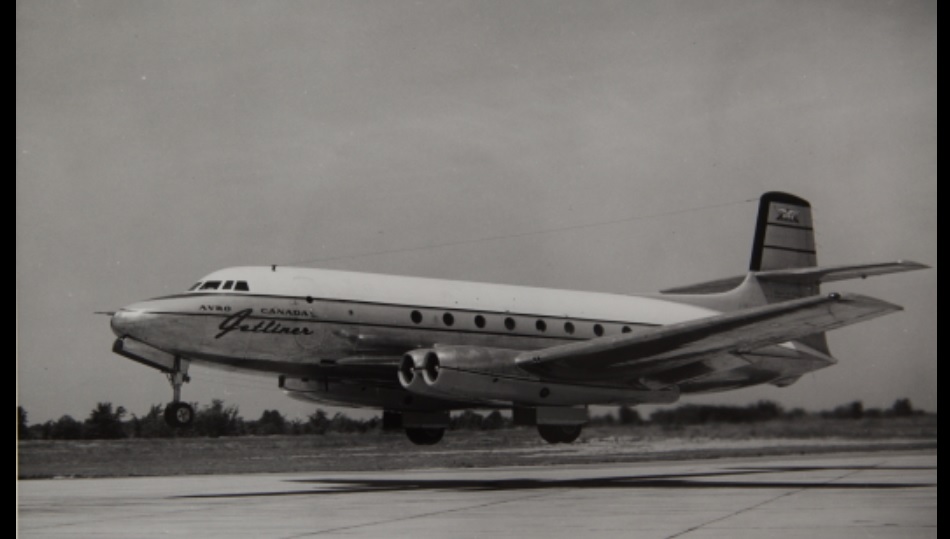
The Avro C-102 Jetliner (shown Dec. 31, 1949) was years ahead of any competitor,and could have been a huge commercial success but was sidelined under orders by the Canadian government. PHOTO: wikicommons
As many have asked over the decades. Where would Canada have been if AV Roe had been able to continue its projects including the world leading ‘Jetliner’ passenger jet, and even a lunar rover.
Additional information-sources
- CBC: D Shield: Jan 6/20: Avro Arrow blueprints on display after sitting in Sask. man’s home for decades
- CTV: J. Visser: Dec 15/11: Avro Arrow mystery deepens with U.K. discovery
- Global News: E.Hobson: Mar 25/13: 55 years later, biggest question surrounding Avro Arrow remains “what if?”
- Saskatchewan Council for Archives and Archivists: Avro Arrow
- Skies: K Swartz:Sep14/18: Former Toronto Aerospace Museum secures new airport home (Arrow replica)
- Diefenbaker Canada Centre: Touch the Sky: The Story of Avro Canada
- Youtube Arrow documentary
- RCI: History- the jet age began in Canada 1950 (Jetliner)
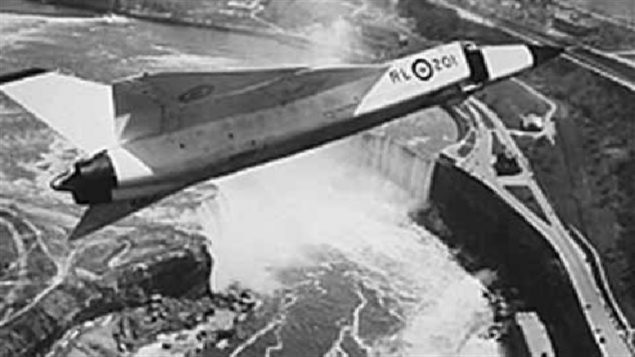






For reasons beyond our control, and for an undetermined period of time, our comment section is now closed. However, our social networks remain open to your contributions.